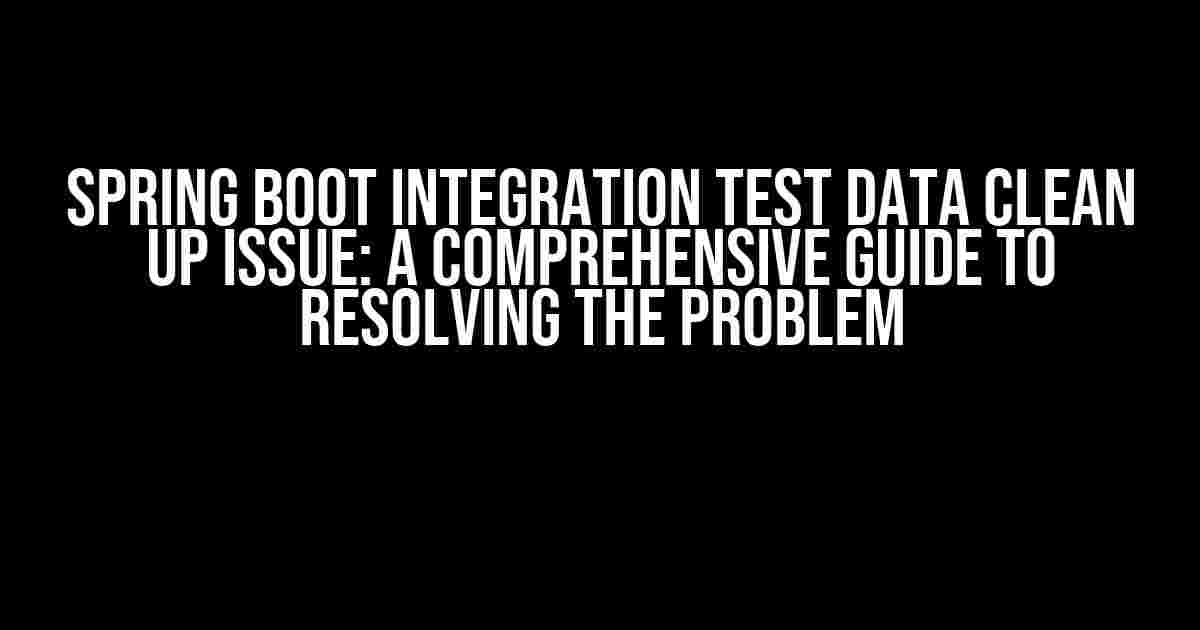If you’re reading this article, chances are you’re struggling with a common issue in Spring Boot integration testing: data clean up. Yes, you’ve written your tests, ran them successfully, but now your database is cluttered with test data and you’re left wondering how to get rid of it. Don’t worry, we’ve all been there! In this article, we’ll delve into the world of Spring Boot integration test data clean up and explore the best practices to resolve this issue once and for all.
What’s the Problem?
When we write integration tests for our Spring Boot application, we often create test data to simulate real-world scenarios. This test data can include anything from user accounts to product information, and everything in between. However, once our tests are complete, this data remains in the database, causing issues with subsequent test runs and even affecting the performance of our application.
So, why does this happen? There are a few reasons:
- Spring Boot’s default behavior is to roll back transactions after each test, but this doesn’t always guarantee that data is deleted.
- Some testing frameworks, like TestNG, don’t support transactional behavior out of the box.
- Our application’s logic might prevent data from being deleted, even when we try to clean up after ourselves.
Understanding the Solution
Before we dive into the solution, it’s essential to understand the concept of transactional testing in Spring Boot. By default, Spring Boot uses the `@Transactional` annotation to wrap each test in a transaction, which is then rolled back after the test completes. This ensures that any changes made during the test are reverted, leaving the database in its original state.
However, as mentioned earlier, this doesn’t always guarantee that data is deleted. To resolve this issue, we need to take a more proactive approach to cleaning up our test data.
Option 1: Manual Data Clean Up
One way to clean up test data is by manually deleting it after each test. This can be achieved by adding a method annotated with `@After` or `@AfterClass` to our test class. This method will be executed after each test or after all tests in the class have completed, allowing us to clean up any test data created during the test.
@After
public void cleanUpTestData() {
// Delete test data here
userRepository.deleteAll();
productRepository.deleteAll();
// ...
}While this approach works, it has its limitations. It can be tedious and error-prone to manually clean up data after each test, especially when dealing with complex data relationships.
Option 2: Using a Test Database
A better approach is to use a separate test database that can be easily dropped and recreated between test runs. This ensures that each test starts with a clean slate, eliminating the need for manual data clean up.
In Spring Boot, we can achieve this by configuring a separate test database in our `application.properties` file:
spring.datasource.url=jdbc:h2:mem:testdb
spring.datasource.username=sa
spring.datasource.password=This configuration creates an in-memory H2 database that’s specific to our test environment. We can then use this database for our integration tests, and Spring Boot will automatically drop and recreate it when we run our tests.
Option 3: Using a Test Data Provider
A more advanced approach is to use a test data provider like Testcontainers or Docker to create a fresh test environment for each test run. These tools allow us to spin up a new database instance for each test, eliminating the need for manual data clean up or test database configuration.
For example, with Testcontainers, we can create a test database container like this:
@Container
public static PostgreSQLContainer postgreSQLContainer = new PostgreSQLContainer("postgres:13.2");
@DynamicPropertySource
public static void properties(DynamicPropertyRegistry registry) {
registry.add("spring.datasource.url", postgreSQLContainer::getJdbcUrl);
registry.add("spring.datasource.username", postgreSQLContainer::getUsername);
registry.add("spring.datasource.password", postgreSQLContainer::getPassword);
}This configuration creates a PostgreSQL container that’s started and stopped for each test run, providing a fresh test environment with no need for manual data clean up.
Best Practices for Spring Boot Integration Test Data Clean Up
Now that we’ve explored the different options for cleaning up test data, let’s discuss some best practices to keep in mind:
- Use a separate test database: This ensures that your test data doesn’t interfere with your production data and makes it easier to clean up test data.
- Automate data clean up: Use a test data provider or a manual data clean up method to ensure that test data is deleted after each test run.
- Keep test data separate from production data: Avoid using production data in your tests, as this can lead to data inconsistencies and make it harder to clean up test data.
- Use transactions wisely: Understand how transactions work in your testing framework and use them to your advantage. If necessary, disable transactions for specific tests to ensure data is committed to the database.
- Test data should be self-contained: Ensure that your test data is self-contained and doesn’t rely on external dependencies. This makes it easier to clean up and minimizes the risk of data inconsistencies.
Conclusion
Spring Boot integration test data clean up can be a daunting task, but with the right approach, it’s a problem that can be easily solved. By understanding the underlying issues and using a combination of manual data clean up, test databases, and test data providers, we can ensure that our tests are reliable, efficient, and don’t leave behind a trail of test data.
Remember, a clean test environment is essential for writing reliable and maintainable tests. By following the best practices outlined in this article, you’ll be well on your way to resolving the Spring Boot integration test data clean up issue and writing tests that truly add value to your application.
| Option | Description | Pros | Cons |
|---|---|---|---|
| Manual Data Clean Up | Manually delete test data after each test | Tedious, error-prone, and limited to simple data relationships | |
| Test Database | Use a separate test database that’s dropped and recreated between test runs | Requires additional configuration, limited to in-memory databases | |
| Test Data Provider | Use a tool like Testcontainers or Docker to create a fresh test environment for each test run | Requires additional setup and configuration, may add complexity |
By choosing the right approach for your Spring Boot application, you’ll be able to write reliable and maintainable integration tests that truly add value to your application. Happy testing!
Frequently Asked Question
Get answers to your most pressing questions about Spring Boot integration test data clean up issues!
What is the purpose of cleaning up test data in Spring Boot integration tests?
Cleaning up test data after integration tests is essential to ensure that the test database remains in a consistent state, allowing for reliable and reproducible test results. This prevents test data from accumulating and affecting the performance of subsequent tests.
How do I clean up test data in Spring Boot integration tests using JDBC?
You can use the @Sql annotation to execute a SQL script that cleans up test data after the test. Alternatively, you can use the JDBC template to execute a delete query or truncate the tables manually. Additionally, you can also use a Hibernate’s clean-up feature to remove test data.
Can I use Spring Boot’s TestRestTemplate to clean up test data in integration tests?
While TestRestTemplate is useful for sending HTTP requests, it’s not designed for cleaning up test data. Instead, use the techniques mentioned earlier, such as @Sql or JDBC template, to clean up test data. However, you can use TestRestTemplate to send a request to a custom endpoint that cleans up test data, if you have implemented such an endpoint.
How do I ensure that test data is cleaned up even when a test fails or is interrupted?
Use the @After or @AfterClass annotations to ensure that test data is cleaned up, regardless of whether the test passes or fails. You can also use a try-catch-finally block to clean up test data in the finally block, which is always executed, even when an exception occurs.
Are there any best practices for cleaning up test data in Spring Boot integration tests?
Yes, some best practices include: cleaning up test data in the @After or @AfterClass methods, using a separate database for testing, using a transactional test approach to roll back changes, and using a cleanup script or tool to remove test data. Additionally, consider using an in-memory database or a test container to speed up test execution and reduce the need for manual cleanup.


